Digital Billboards: Traffic Hazard and Architectural Landscape
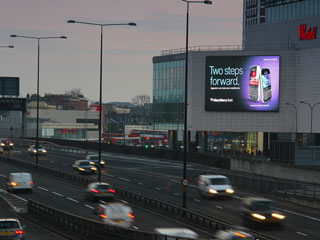 An advertising LED billboard 15x9 m in London
An advertising LED billboard 15x9 m in LondonPhoto credit: Ocean Outdoor
A Russian proverb describes a fickle person as “having seven Fridays in one week”. Meaning “says one thing one day, and another the next”. We are talking about digital billboards, of course. Their number in Russia is constantly growing, their quality is improving, LED billboards merge into networks, and digital advertising is on the rise following the general worldwide tendencies. Suddenly Moscow authorities announce that digital billboards and dynamic outdoor advertising are hazardous and should be used only in slide-show mode or dismantled altogether.
“According to new rules we are distancing away from dynamic advertising on digital billboards”, says Vladimir Chernikov, Head of Mass media and Advertising Department in Moscow Government. As an alternative he suggests to install 6-7 thousand advertising kiosks on Moscow sidewalks. Sounds as an exciting suggestion to get back to the pre-technological times.
We published a couple of articles on a similar topic: “Outdoor Advertizing Screens and Traffic Hazards”, “Digital LED Screens and American Bureaucracy” and this statement from the Moscow Government official prompted us to consider once again what other countries think and do about dynamic advertising.
Outdoor Digital Billboards as a Traffic Hazard
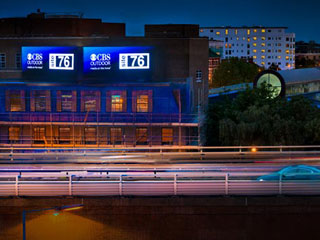 Two LED billboards in London on М4 highway
Two LED billboards in London on М4 highwayPhoto credit: prismaflex.com
Let us begin with risk factors. Consider the scenario: a person is driving a car, sees a digital billboard with video ahead, watches the video, forgets about the surrounding traffic and creates a potentially dangerous situation. Is that how it happens? Here is a quote from a comprehensive research by Romir Monitoring, an exclusive representative of Gallup International in Russia. It turns out that drivers place road adverting (both static and dynamic) on the 12-th place (7%) in the list of all theoretically hazardous factors.
The highest risk category was given to unusual behavior of other vehicles (58%) and inadequate behavior of pedestrians (57%) as well as unexpected weather conditions (42%). Only seven percent of drivers think of road advertising as dangerous. Potentially. In reality road advertising becomes a cause of road accidents in less than 1% of cases. It means that outdoor advertising (both static and dynamic) is the lowest possible risk factor of all that were identified during an extensive research. It included:
- Passengers’ behaviour inside a vehicle
- Use of a mobile phone while driving
- Distraction from radio or CD-player in a vehicle
- Technical faults of a car
- Poor physical or emotional condition of a driver
- Smoking while driving
The US-led study released in 2006 by VTTI for the National Highway Traffic Safety Administration (NHTSA) identified a two second threshold for increased risk due to distraction: “Glances totaling more than two seconds for any purpose increase near-crash/crash risk by at least two times that of normal, baseline driving.” The typical glance toward a digital billboard is well under the threshold. Each study reached the same conclusion: there is no correlation between digital billboards and traffic accidents.
Digital Billboards and City Architecture
Do digital billboards negatively affect the city landscape? This is a more difficult issue since it involves opinion and preferences, not facts. Digital billboard is a part of “advertising structures” category. City authorities the world over fight the invasive outdoor advertising, clean cities of unlawful structures, clusters of advertising etc. On the other hand digital billboards add color and unusual shapes to city architecture. We wrote about it in many articles here. This is also an opinion of some competent professionals from different countries.
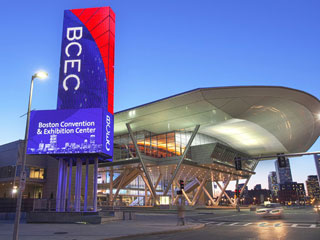 LED billboards at the Boston Convention & Exhibition Center
LED billboards at the Boston Convention & Exhibition CenterPhoto credit: signageinfo.com
Here is the opinion of the Boston City Council about Boston Convention & Exhibition Center Marquee and Video Wall that in 2012 received the Award of Excellence: “It's so great when digital technology does not come off as an “add on”, but rather lives seamlessly within the architecture of the structure.”
Or consider an opinion of the Cleveland Councilman: “Digital billboards are right in line with the whole cityscape. They communicate that we are a city that embraces technology. We actually have some of the newest state-of-the-art, cutting edge advertising”. There are hundreds similar quotes. But what is more important is the tendency. The population of outdoor digital billboards, continues to grow fast. Not as fast as we would like it to be.
For example, the USA, the most advanced country in terms of state-of-the-art advertising, has only 3600 outdoor digital billboards out of the total of 400 thousand advertising structures. Russia has only about a 1000 outdoor digital billboards. But this number is rising, and that means that they are in demand. Digital advertising structures (LCD or LED) improve quality of ads, ensure fast change of content, are cost effective and efficient in targeting preferable customer groups. Although initially digital billboards require heavy investments, the operational costs are much lower on digital screens since all adverting may be changed by a simple command from a control center without expensive printing and manual placing of new paper ads on static billboards.
Times Square in New York – the best exhibition center of LED billboards
Video credit: youtube.com
The last issue to consider: dynamics of video image. Long time ago (in the very beginning of the 21-st century – and in the short history of digital billboards this amounts to half an eternity) the Federal Highway Administration (FHWA) issued a guidance memo on using digital billboards along US highways. At that time digital billboards were still a novelty to be feared and the recommendations were very cautious: LED billboards were supposed to work in slide show mode with the image changing every 8 seconds. In some states digital billboard keep following those old rules.
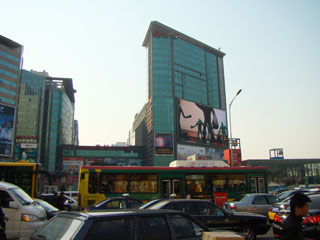 |
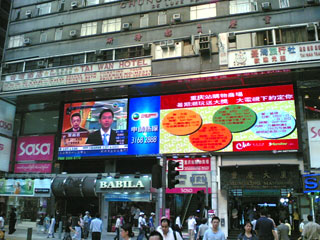 |
| Huge LED billboard in central China | Advertising and informational LED billboards on a mall in Hong Kong |
Since then outdoor digital billboards became common, statistics is available on their operation and safety, and in many US towns billboards were allowed to resume the video mode. In some other countries overflowing with outdoor advertising such limitations never bothered anyone. For example, in China there are thousands of digital billboards along roads and no limitations whatsoever. Digital billboards simply do not affect drivers! The billboards are in evidence everywhere – large, medium and small – and only operate in slide show mode when this is required by the advertisers.
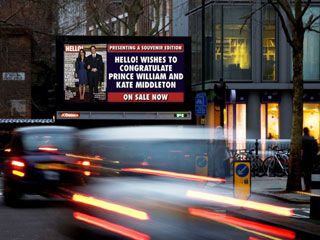 An LED billboard operated by JCDecaux
An LED billboard operated by JCDecauxPhoto credit: outputmagazine.com
Europe refused to follow in the US steps. For a long time many European countries maintained strict limitations on setting up new digital billboards. However once the billboard was in place it could be use in video mode at all times.
In England digital billboards broke the administrative inertia on the eve of the Summer Olympics - “Large Outdoor Digital Billboards at the London Olympics”, and today city councils are overflowing with requests for installation of new digital billboards, including areas along highways.
For example, in USA and Europe digital billboards are traditionally included in public security programs like Amber Alert. In July 2012 there appeared information about successful search for a lost teenager in UK after only one day campaign using outdoor digital screens.
Do not forget about emergency situations, like the tragedy with NY twin-towers, when digital billboards all around the country turned into huge street TVs broadcasting live news from the site - “Large Outdoor Displays Application”.
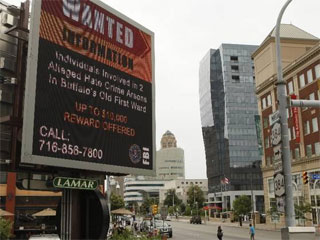 LED billboard in Buffalo with an notice seeking information on Old First Ward fires
LED billboard in Buffalo with an notice seeking information on Old First Ward firesPhoto credit: buffalonews.com
Digital billboards have long stopped being just the advertising carriers. Today they fulfill an important function of informing public about current or emergency events, about everything important, urgent or useful. New informational media is gradually emerging in the streets and squares of our towns. And all this due to outdoor digital billboards.
In this context the wish of Moscow authorities to prohibit or limit the use of digital billboards seems like an attempt to swim against the current. Pretty useless, to say the least!





